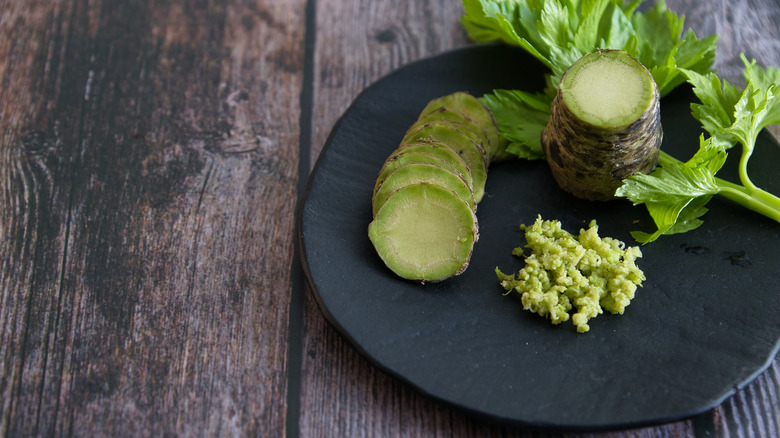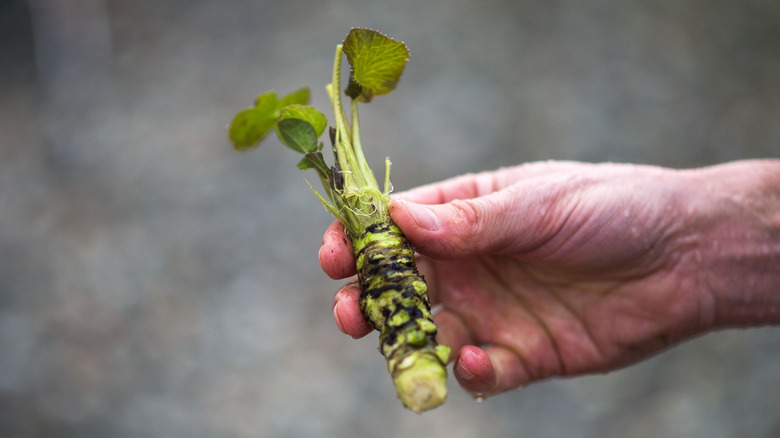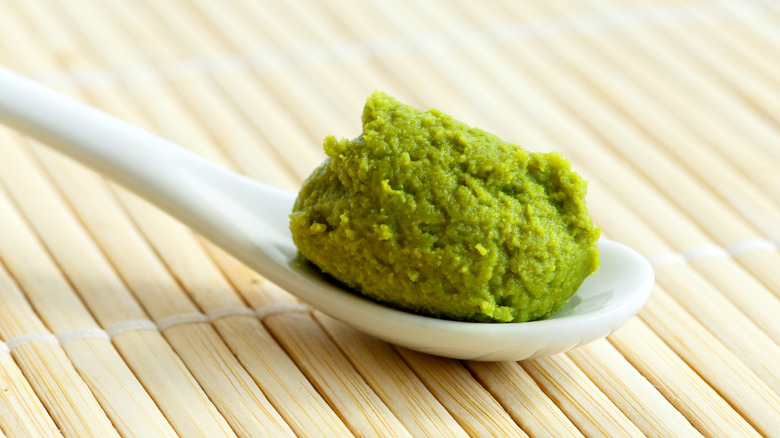Chances Are, Your Wasabi Is Another Ingredient In Disguise
It's hard to forget your first time eating wasabi. This pungent green condiment, usually served alongside sushi and quite popular in Japanese cuisine, has a distinctive flavor, a sharp bite that pierces your nose and clears your sinuses in a snap. But as it turns out, the flavor of wasabi might not be as distinctive as you would expect. In fact, that spicy green paste served with your California roll might not even be wasabi at all, but a cheap substitute used to save restaurants money and leave their customers none the wiser.
Fans of Lemony Snicket's "A Series of Unfortunate Events" children's book series may already know where this is going, as the similarities between wasabi and its common stunt double played a role in the climax of the series' eleventh volume. But for those unfamiliar with the culinary exploits of those brilliant orphans, we won't hold out on you. So what is it that you're likely eating that looks an awful lot like wasabi? Horseradish dyed with green food coloring.
What is real wasabi?
True wasabi, known as hon-wasabi in Japanese, actually comes from a root vegetable in the same family as European horseradish, known as seiyo-wasabi. Both are in the Brassicaceae family, which encompasses spicy mustard greens, radishes, and cruciferous vegetables; and wasabi is also commonly known as Japanese horseradish. But unlike European horseradish, which is plentiful and affordable worldwide, wasabi is difficult to grow and native to Japan, making it far more expensive.
To cut costs, horseradish is often dyed green and packaged with a very small amount of true wasabi mixed in, then sold commercially as the real thing. Fillers like tapioca are sometimes added as well, as are vinegar and mustard powder. While there is a difference in flavor (true wasabi is often described as having a "cleaner" profile that is more nuanced and even sweet), that sharp sting both share is enough to trick most consumers into thinking they've had the real deal.
How to tell if you're eating fake wasabi
Generally, if your wasabi is coming in packet form, or in a chunky little pile on the side of a plastic supermarket sushi container, it's probably the fake horseradish-based seiyo-wasabi. Real wasabi is expensive and loses its flavor quickly after being grated, which is why restaurants that serve real wasabi will often serve it fresh, grating it from the whole root. This results in a grittier texture than that of fake wasabi, which is smooth from being puréed. Real hon-wasabi also doesn't have that intense green color of dyed wasabi, and is usually paler.
If you want to get your hands on the real stuff, you'll have to do a little digging. Try searching Asian grocery stores or gourmet online retailers, and look for the plant's botanical name Wasabia japonica on the label. You can order whole wasabi rhizomes online (though these are quite expensive), or you can search for wasabi powders that need to be rehydrated with water before use.



